CDC SOFT HACKLE MAYFLY EMERGERS
Where do the ideas for new fly patterns come from, some are bourne on the water by observation, some ideas are a mixture of material and some are nothing more than combining old establish pattern styles with more modern pattern or even combining wet flies with dry flies and generally these patterns are simple to construct and imitate that most important factor in an imitation and that is the illusion of life and such is the story of the CDC Soft Hackle Emergers.
Over the past couple of years I have wrote extensively on the subject of Soft Hackle fished both wet and dry along with a reasonable history on the subject. I also began to play with a CDC Soft Hackle Emerger for mayfly hatches. I offered one of these patterns in one of the selections published in FAOL during the 2013.
Since that time I have come up with several patterns which I have used throughout Montana and on the waters of Yellowstone National Park along with several different streams across the country. The success of this pattern has been remarkable and I can take little credit for this pattern as the soft hackle pattern has been around for years. Furthermore anglers have been using CDC for enhance various pattern for year and all I did what combine a pattern (soft hackles) that was traditionally fished wet and CDC patterns which traditionally are fished dry.
The patterns are fished dry with only the wings being dressed with floatant suitable for CDC patterns, other than that when the rest of the patterns begins to sink to far beneath the surface then the pattern is either false casted dry. Now this pattern can be used in the dead-drift manner. But I actually prefer to twitch the imitation to enhance the life-like qualities of the imitations.
Now in this selection I will also be introducing the CDC Soft Hackle Caddis Emerger which I have had good success with on the waters of Montana and Yellowstone National Park.
The pattern which began this whole project was the PMD CDC Soft Hackle Emerger and while patterns can be designed for individual hatches I found that a few patterns might be constructed to cover a wide range of hatches, now that still doesn't mean that I haven't created patterns for Western Trico's and Sulfur Hatches but the remainder of the hatches I can normally get by with one of the patterns listed below. Now I carry these patterns in wide range of sizes.
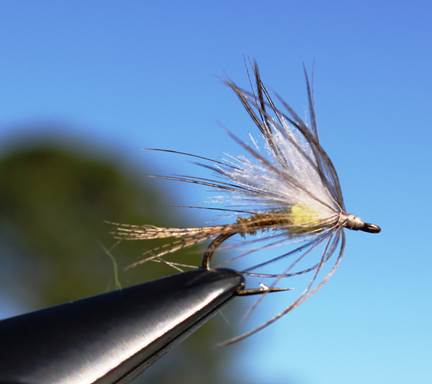
Pale Morning Dun CDC Soft Hackle Mayfly Emerger
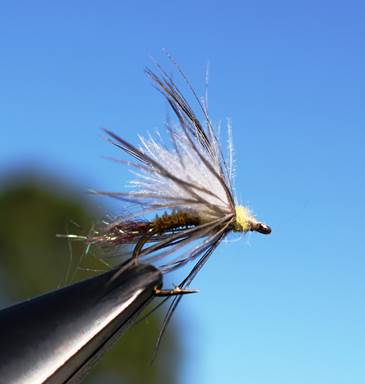
This is another PMD variation where a rolled dubbing shuck was used and a small head is dubbed using the PMD dubbing.
On all the other patterns the shuck is listed as Optional, but this is the only pattern which was photographed with a shuck.
PMD CDC Soft Hackle Emerger
- Hooks: Dai-Riki #125, TMC 2487 or Daiichi 1130 Sizes: 14-20
- Thread: Sandy Dun 12/0
- Tails: Wood-duck Flank Fibers
- Abdomen: BWO Olive Turkey Biot or Turkey Wing Fibers, wrapped
- Thorax: Dubbed, PMD beaver or synthetic of choice
- Wings: Light Dun CDC Fibers, tied short
- Hackle: Valley Quail back feather, Bluish dun in color, wrapped in 1½ or 2 turns
Note: The wings on the pattern can be dressed with floatant appropriate for CDC but the body sets on top the film and frankly needs no, dressing other than to false cast off excess water between presentations. Once a trout is caught on the pattern simply use a drying agent like Frog's Fanny to restore the pattern to its original form.
Tying Notes: The wood-duck tail might be switched out with a shucked comprised of Light Brown Olive Antron dubbing fibers which are rolled between thumb and forefinger and tied into the tail position.
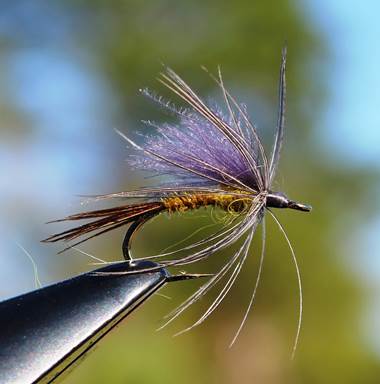
Dark Olive CDC Soft Hackle Emerger
- Hooks: Dai-Riki #125, TMC 2487 or Daiichi 1130 Sizes: 10-22
- Thread: Dark Dun 12/0
- Tails: Dark Olive Pheasant Tail Fibers
- Shuck: Rolled Antron Brown Olive Dubbing (Optional)
- Abdomen: Turkey Biot or Turkey Wing Fibers dyed Blue Wing Olive
- Thorax: Dubbed, Medium Olive Beaver fur or synthetic
- Wings: Dark Dun CDC Fibers
- Hackle: Valley Quail Back Feather, 1½ to 2 wraps
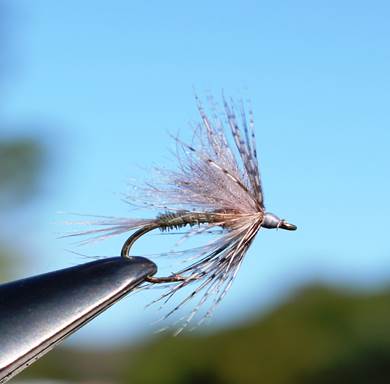
Light Olive CDC Soft Hackle Emerger
- Hooks: Dai-Riki #125, TMC 2487 or Daiichi 1130 Sizes: 10-22
- Thread: Light Dun 12/0
- Tails: Medium Dun Wet Hackle Fibers
- Shuck: (Optional) Pale Gray/Olive Antron dubbing Fibers, Rolled
- Abdomen: Gray/Olive Turkey Wing Fibers or Biots
- Thorax: Dubbed, Tan dyed Beaver Fur or superfine dubbing
- Wings: Medium Dun Barred CDC Feathers, tied short
- Hackle: Natural Hungarian Partridge back feather, 1½ to 2 turns
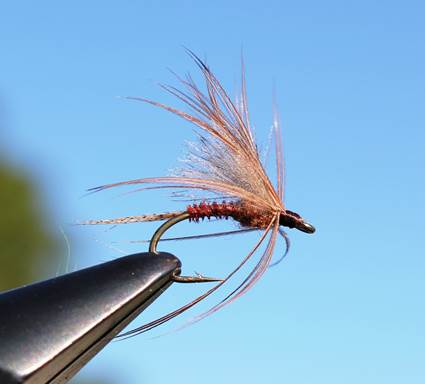
Tan & Brown CDC Soft Hackle Emerger
- Hooks: Dai-Riki #125, TMC 2487 or Daiichi 1130 Sizes: 10-22
- Thread: Brown 12/0
- Tails: Wood-duck Flank Fibers
- Shuck: (Optional) Pale tan antron dubbing fibers, rolled
- Abdomen: Brown Turkey Biot or Wing Fibers wrapped
- Thorax: Tan and Brown Beaver Fur mixed, March Brown
- Wings: 2 Barred Light Brown CDC feather on inside with 2 Barred Dark Dun CDC feathers on the outside, one on either side of the brown
- Hackle: Natural Chukar back feather
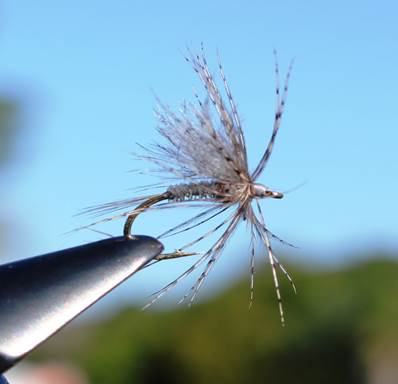
Gray CDC Soft Hackle Emerger
- Hooks: Dai-Riki #125, TMC 2487 or Daiichi 1130 Sizes: 10-22
- Thread: Light Dun 12/0
- Tails: Grizzly Hen Hackle Fibers
- Shuck: (Optional) Grayish Tan Antron dubbing, rolled
- Abdomen: Muskrat Gray Turkey Biot or Wing Fibers, wrapped
- Thorax: Dubbed, Grey Muskrat under-fur or superfine
- Wings: Barred Medium Dun CDC Fibers
- Hackle: Natural Hungarian Partridge back feather
With the exception of a Trico and a Sulfur Soft Hackle Emerger these emergers that I have listed above will cover most the May Fly Hatches that I encounter and that is why I carry them in a wide range of sizes. Now could add the other two patterns but I figure that you all would want to design your own color variations of these two hatches.
These are very effective emergers, however they are not God flies which never fail. Due to the CDC and the use of Soft Hackle Fibers, they appear to be alive and struggling in the surface film and a fairly easy to see, even in the smaller colors.
CDC Soft Hackle Emerging Caddis
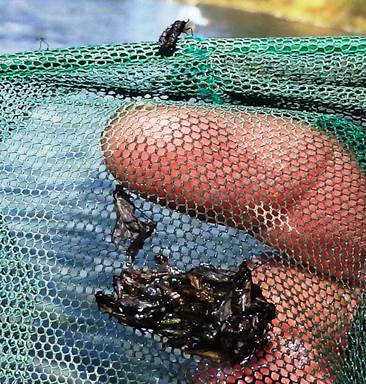

Caddis Hatches can bring up every trout in the river, however the egg laying flight may or may not generate any interest from the trout, depending on the conditions of the day.
From the very beginning Caddis Flies have been on the angler's radar however the main focus of the anglers was the May Fly. Slowly through the centuries the knowledge base of caddis flies grew. Again for me it was the combination of Soft Hackle and knowledge of the insects put forth by Gary LaFontaine, Eric Leiser and Larry Solomon and many other and the CDC innovations I have seen at the vices of many of the great fly tiers of the world.
Caddis are without a doubt the most interesting of the emergers to imitate and fish, the imitations can be as simple soft hackles designed to match the colors of the naturals or they can be more involved, both styles will work.
The angler also faces the problem of coming up with a series of imitations which would cover the multiple number of different caddis hatches that can be encountered throughout the season.
Now the emergers that I will be introducing are designed to fish in and on the surface film and can be soaked to fish just beneath the surface film. Emerging caddis pupa are moving, swimming and drifting toward the surface and this swimming motion and change of direction is what makes some of the takes appear to be very aggressive as this is an organism that can escape the clutches of the hungry trout. The color selection I have chosen to present will cover most of the hatches found in Montana and the waters of Yellowstone National Park. Furthermore I have excellent results on mid-west and eastern streams as well.
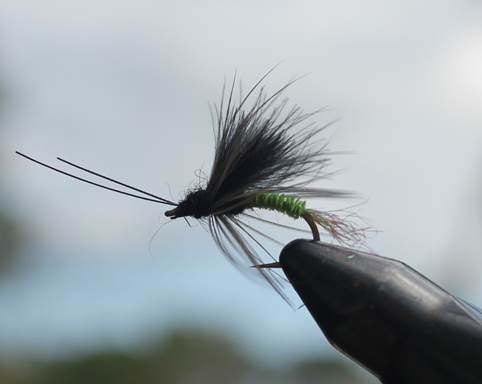
Black & Green CDC Soft Hackle Caddis Emerger
- Hooks: Tiemco 2488 - Sizes: 10-22,
Tiemco 2487 - Sizes: 10-22
Tiemco 200R - Sizes: 12-22
Dai-Riki #15 - Sizes: 12-22 - Thread: Black 12/0
- Shuck: (Optional) Peacock UV Dub, rolled
- Abdomen: Caddis Green Turkey Wing Fibers, tied in by the tips and wrapped
- Thorax: Dubbed, BWO Beaver Dubbing
- Wings: Black CDC Feathers, Four bunched together
- Collar: Valley Quail, Back feather, 1½ to 2 turns
- Head: Dubbed same as Thorax
- Antennae: One pair of black hackle stems
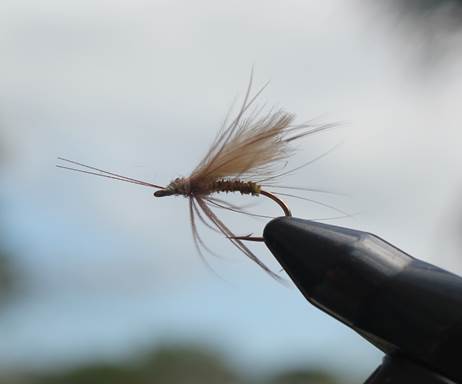
Tan CDC Soft Hackle Caddis Emerger
- Hooks: Tiemco 2488 - Sizes: 10-22
Tiemco 2487 - Sizes: 10-22,
Tiemco 200R - Sizes: 12-22
Dai-Riki #15 - Sizes: 12-22 - Thread: Tan 12/0
- Shuck: (Optional) Tan UV Dubbing, rolled
- Abdomen: BWO Turkey Wing Fibers, tied in by tips and wrapped
- Thorax: Tan Beaver Dubbing
- Wings: Natural Tan CDC Fibers, 4 feathers clumped together
- Collar: Natural Chukar Back Feather, 1-1/2 to 2 turns
- Head: Dubbed as same as the thorax
- Antennae: Natural Brown Hackle Stems
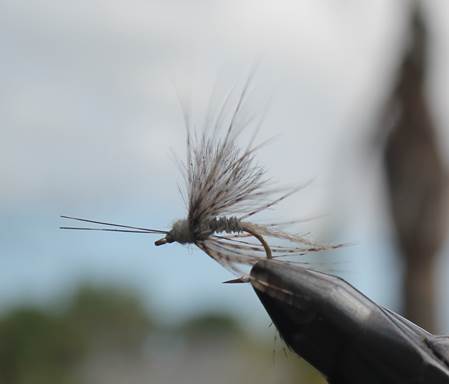
Gray CDC Soft Hackle Caddis Emerger
- Hooks: Tiemco 2488 - Sizes: 10-22,
Tiemco 2487 - Sizes: 10-22,
Tiemco 200R - Sizes: 12-22
Dai-Riki #15 - Sizes: 12-22 - Thread: Light Dun 12/0
- Shuck: (Optional) Gray UV Dubbing, rolled
- Abdomen: Muskrat Gray Turkey Wing Fibers, tied in by the tips and wrapped
- Thorax: Beaver Dubbing, Gray
- Wings: Medium Dun Barred CDC Feather, 4 feathers clumped together
- Collar: Natural Hungarian Partridge Back Feather
- Head: Dubbed, same as thorax
- Antennae: A pair of Grizzly Hackle Stems
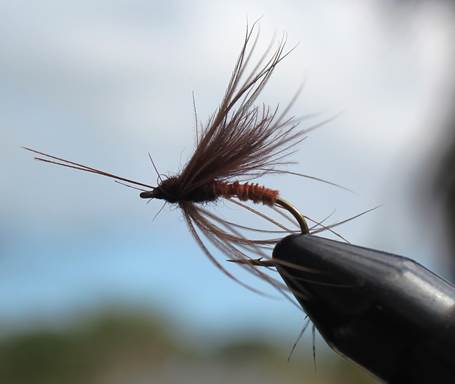
Brown CDC Soft Hackle Caddis Emerger
- Hooks: Tiemco 2488 - Sizes: 10-22,
Tiemco 2487 - Sizes: 10-22,
Tiemco 200R - Sizes: 12-22
Dai-Riki #15 - Sizes: 12-22 - Thread: Brown 12/0
- Shuck: (Optional) Tan UV Fibers, rolled
- Abdomen: Dark Tan Turkey Wing Fibers, tied by the tips and wrapped
- Thorax: Beaver Dubbing Brown
- Wings: Medium Brown CDC Feathers, 4 feathers clumped together
- Collar: Natural Chukar Back Feather, 1-1/2 to 2 turns
- Head: Dubbed same as the thorax
- Antennae: A pair of Natural Brown Hackle Stems
These four patterns carried in a variety of sizes have produced very well for me and has allowed me take many whitefish. Hope they work well for you.
Enjoy & Good Fishin'
